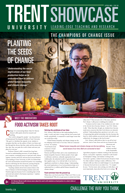 New Bird Study Reveals How Maternal Stress Leads to Stronger OffspringFOR IMMEDIATE RELEASE Trent and Simon Fraser University Researchers Discover Clue Explaining How Birds Adapt to Difficult Environments Wednesday, October 8, 2008, Peterborough In a study published today in the prestigious scientific journal Proceedings of the Royal Society, researchers experimentally increased yolk levels of the stress hormone corticosterone in European starling eggs, to mimic the signal offspring receive that they will be raised in a low quality environment. Surprisingly, exposed fledglings actually left the nest with increased flight performance, mechanistically driven by larger, more mature flight muscles, lower wing-loading and increased muscle enzymes. “These findings were entirely backwards to what we expected,” said Dr. Gary Burness, a biology professor at Trent University who co-authored the study. “However, when we realized that the young birds exposed to the stress hormone showed developmental improvements across so many indicators, we knew this was a significant finding.” The lead author of this study was graduate student Eunice Chin, who is pursuing her Ph.D. degree through the Environmental and Life Sciences program at Trent University. She and her colleague Dr. Oliver Love from SFU analyzed five aspects of the starlings’ physical development: flight ability, size of breast muscle, wing area, enzymes in flight muscles, and muscle water content. Ms. Chin, together with Professor Burness, and SFU collaborators Drs. Love and Tony Williams, concluded that the positive effects of stress hormones on flight performance may balance some of the negative developmental costs reported by other researchers. “We believe that offspring may use this hormonal signal from their mother to better prepare for their own future environment,” explained Prof. Burness. “It’s also highly likely that other birds, and perhaps some mammals, transmit information in a similar way.” -30- For further information, please contact: Professor Gary Burness Eunice Chin |

































 Researchers from Trent University and Simon Fraser University (SFU) have discovered that hormones released by stressed mother starlings actually improve the physical development of their offspring.
Researchers from Trent University and Simon Fraser University (SFU) have discovered that hormones released by stressed mother starlings actually improve the physical development of their offspring.